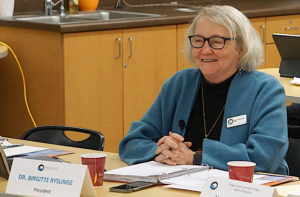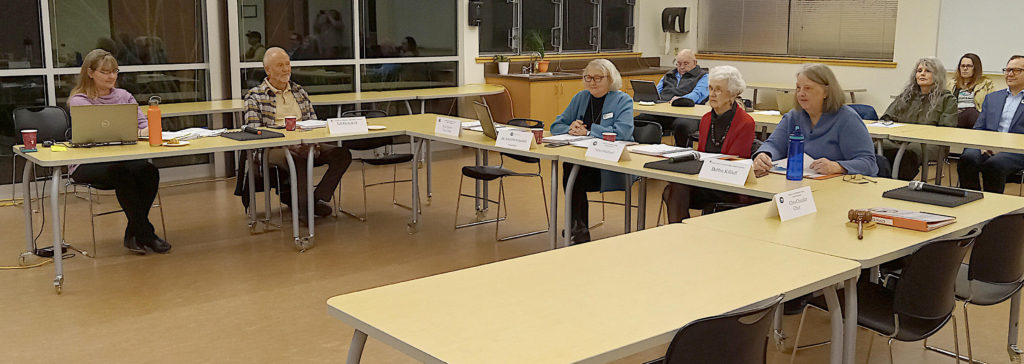
By KENNETH LIPP/YachatsNews
The Oregon Coast Community College board is moving forward with a May ballot question – asking Lincoln County voters to approve $32 million in bonds to build a cutting-edge trades education center on its main campus in South Beach.
During the board’s monthly meeting Wednesday, chair Chris Chandler directed business quickly between the agenda’s action items following lengthier reports from staff and liaisons, the last of which was the bond measure. Chandler was among several board members joining remotely via Zoom.
The unanimous vote in favor was met with applause, and Chandler said she was grateful to the state for “putting $8 million on the table.”

The state approved the college for an $8.14 million grant more than five years ago to create spaces and programming that contributes to the workforce — if the college more than matches that investment with funding from a bond.
David Price, vice president of engagement, told YachatsNews the college wasn’t prepared to do so at the time, but after getting accreditation in 2020 and weathering the pandemic, it was looking toward the future. Price said there were also concerns that with a recession looming, the state might decide to cancel unclaimed grants. Seeking a new bond is listed among the board’s goals for 2022-23.
College president Birgitte Ryslinge said in January that expanding trades education has long been on the college’s roadmap.
“Since joining OCCC in 2014, I have often been asked ‘When will the college offer more training opportunities for students looking to work in the trades?’” she said. “After careful examination of employer and student demand, we concluded this was absolutely an area where we needed to grow. And we do not have the specialized facilities needed to house complete trades programs.”

Oregon Coast Community College board members unanimously adopted a resolution Wednesday to ask voters to approve a $32 million bond to build a trades education center and fund upgrades and equipment at existing facilities. From left are executive assistant to the president, Lori Templeman, board member Jeff Ouderkirk, college president Birgitte Ryslinge, and board members Nancy Osterlund and Debbie Kilduff.
What is it for?
With the lone tax measure on Lincoln County’s ballot in May, OCCC will ask voters to issue up to $32 million in bonds to:
- Construct a new trades education center expanding career options in skilled trades for Lincoln County residents, at a cost of approximately $25 million;
- Expand, adapt and modernize existing career technical training facilities and acquire land supporting programs including education, allied health, applied aquatic sciences, and welding;
- Update classrooms, technology, facilities, and equipment providing students with modern higher education and job training spaces, including flexible hybrid learning options to meet student needs into the future;
- Enhance facilities and acquire equipment contributing to community emergency response infrastructure;
- Make improvements to existing facilities increasing lifespan and efficiency; and
- Make site improvements, buy furnishings and equipment, and pay bond issue costs.
Dan Lara, vice president of academic affairs, said in a college press release last month that the trades facility will be designed “as a cutting-edge, flexible, industrial space.”
“Virtually all the fixtures in this facility will be on wheels so that classrooms, workshops, and other learning spaces can flex and adapt over time to meet changing needs – the needs of our students and our county’s employers,” he said.
During an enrollment report Wednesday, Lara told the board that although the most recent enrollment targets were not met after the pandemic-driven slump in 2021, they were on an upward trend, and he expected to meet targets in the near future.

Some instruction areas have seen enrollment drop while others have had a significant increase, Lara said, in particular career-technical education programs, GED and English as a second language courses. He suggested some of that increase in career tech might have been spurred by the 2019 launch of a welding program in cooperation with the Port of Toledo, a program the college intends to use bond funds to enhance.
The college also plans to use some funds toward emergency preparedness measures, such as designing the parking lot for the new building on the Newport campus to serve as an emergency helipad for heavy rotor aircraft in the event of a large natural disaster. It is also considering a dual-fuel generator coupled with a low-power FM station at its Lincoln City campus to support city and county efforts to communicate with the public and manage events such as the evacuation caused by the 2020 Echo Mountain fires.
What will it cost taxpayers?
In 2004, voters approved an OCCC bond measure of 34 cents per $1,000 assessed property value to build the college’s first facilities. As property values grew, that rate declined to an average of 24.4 cents and is expected to be 21 cents per $1,000 assessed value this year. With that, the owner of property assessed at $300,000 pays $73 a year to pay off the college bonds. This bond matures in 2025.
The new proposal calls for a bond with a tax rate of 26 cents per $1,000 assessed property value — a yearly property tax bill of $78 for a $300,000 property, $5 more than the current amount. If approved by voters May 16, the new tax will go into effect July 1. The bonds would mature in 2044.
The college also has a permanent tax base of 17.6 cents per $1,000 assessed value that provides yearly operating funds. That costs the owner of property assessed at $300,000 about $53 a year.
Oregon Coast Community College was formed in 1987, but operated under the charters of other Oregon colleges until 2020 when it became an independent institution with the ability to make its own financial and academic decisions. With a fall 2022 headcount of 908 students, it is the fourth smallest of Oregon’s 17 community colleges.



You will never convince me that at the cost of tuition Oregon Coast CC can’t pay for this themselves. They can afford it more than I can on my social security.
There is also a shortage of qualified craftsmen/women: home repair and upgrades including electrical, plumbing, woodworking, painters, etc. A lot of the skilled workers I know and have used in the past are backlogged and/or retiring/retired. In addition to welders, mechanics, refrigeration specialists, and other industry service providers should be considered. So much work is contracted out of county. Delays and travel costs those who reside here, and skilled job opportunities that pay well will definitely benefit our communities.